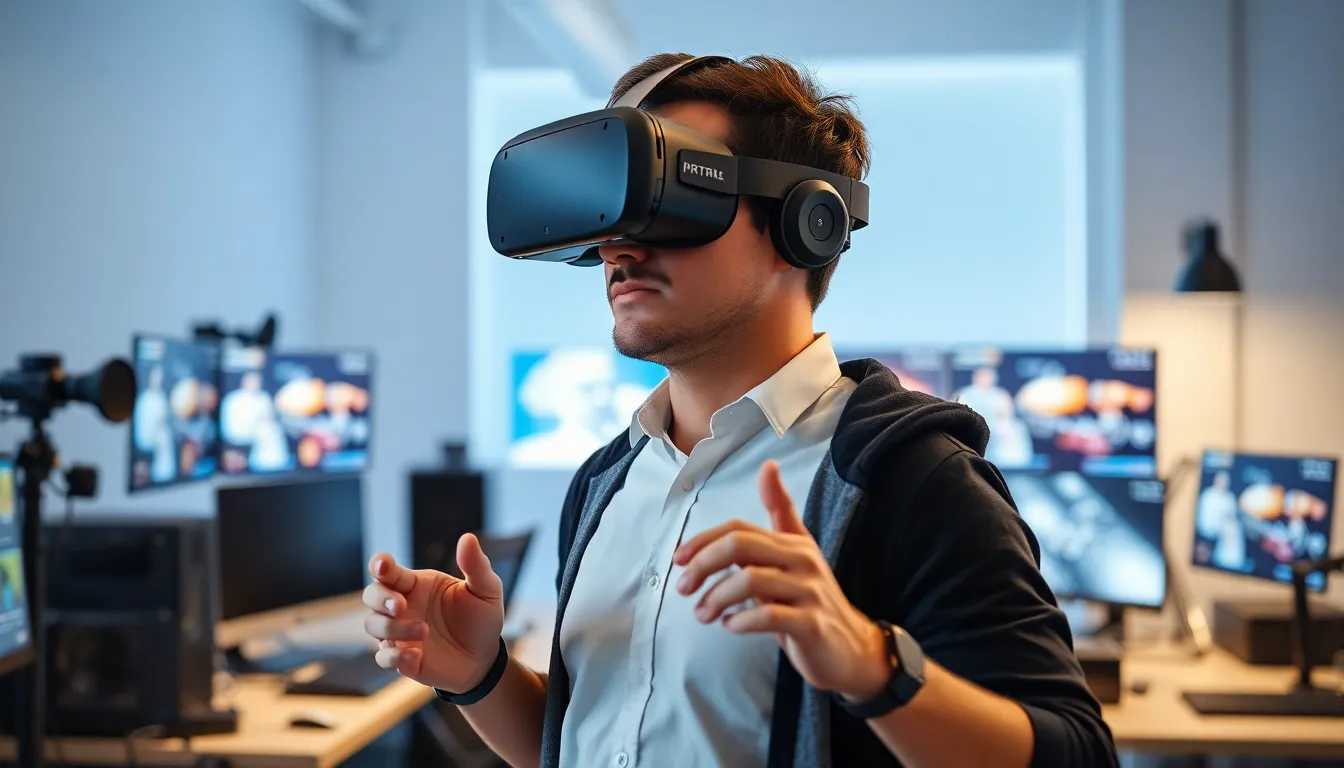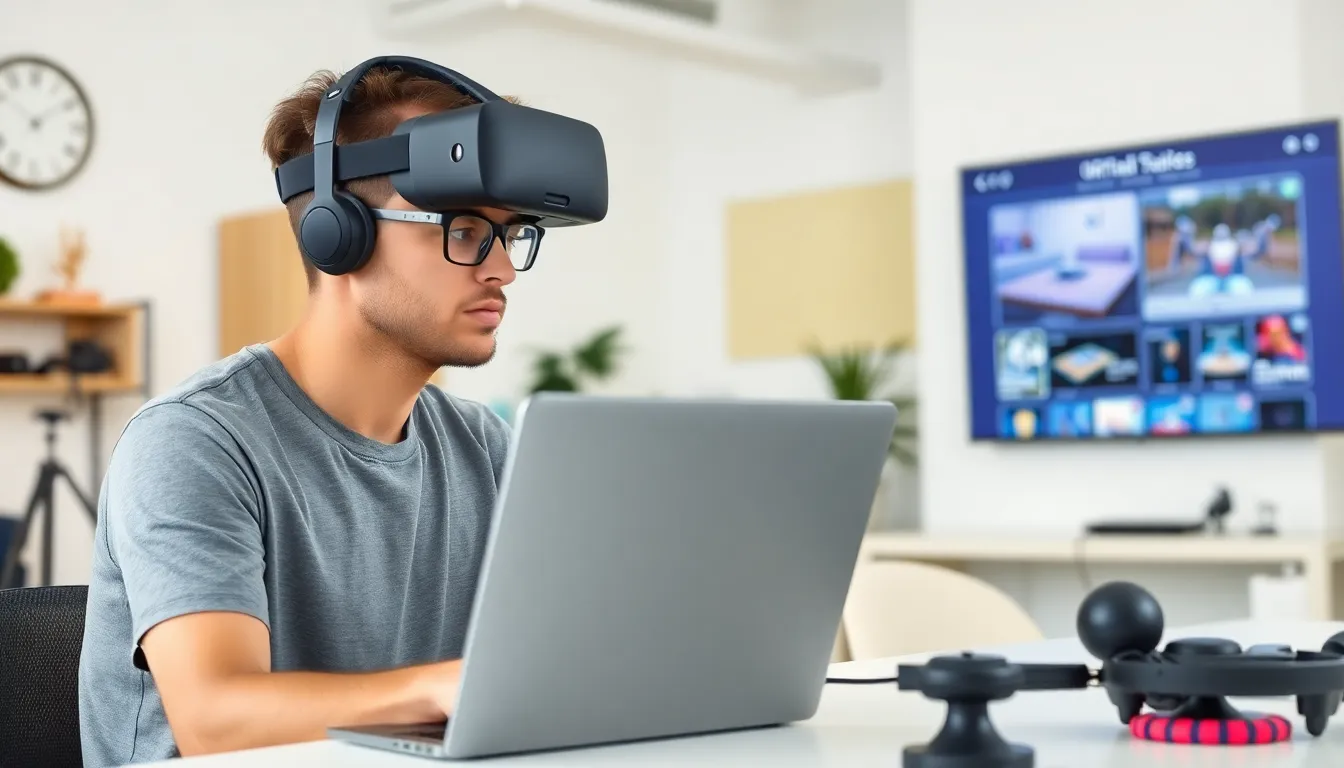In a world where reality sometimes feels a bit too mundane, virtual reality (VR) swoops in like a superhero with a cape made of pixels. Imagine stepping into a realm where the only limits are your imagination and maybe your Wi-Fi connection. From gaming to training simulations, VR app development is transforming how people interact with technology and each other.
But let’s face it—creating a VR app isn’t as easy as pie, especially if that pie is floating in zero gravity. Developers must juggle creativity, technical skills, and a sprinkle of magic to craft immersive experiences that keep users coming back for more. Dive into the fascinating world of virtual reality app development and discover how this cutting-edge technology is reshaping industries and turning dreams into digital adventures.
Table of Contents
ToggleOverview of Virtual Reality App Development
Virtual reality app development involves creating applications that provide immersive experiences in simulated environments. Developers leverage various tools and technologies for designing VR content across multiple platforms. These applications find significant use in gaming, training, education, and healthcare.
Creating VR apps requires a solid understanding of 3D modeling and animation techniques. Developers commonly use software such as Unity or Unreal Engine for building immersive worlds. Rigorous testing is essential for ensuring seamless interaction between users and virtual environments.
User experience plays a vital role in VR app development. Factors like accessibility, motion sickness minimization, and user interface design can significantly impact usability. Iterative design processes allow for ongoing user feedback, leading to refined experiences.
Integration of different technologies enhances VR app functionality. Developers often combine VR with artificial intelligence or augmented reality to create more engaging applications. This combination can provide users with enriched experiences.
Performance optimization is crucial in VR development. High frame rates and low latency are necessary for creating smooth and realistic experiences. Developers prioritize these aspects to ensure user engagement and retention.
Staying updated with the latest industry trends is key for developers. Advancements in hardware and software are frequent, providing new opportunities for VR applications. Engaging in continuous learning ensures that developers can harness the latest innovations to elevate their projects.
Key Technologies in Virtual Reality

Virtual reality development involves several key technologies that enhance user experiences and application performance. Understanding these components is essential for developers.
VR Headsets
VR headsets serve as the primary hardware for immersive experiences. Models like the Oculus Quest 2, HTC Vive, and PlayStation VR offer different features and specifications. Each headset typically includes a combination of displays, sensors, and audio systems. Effective tracking mechanisms are crucial, as they allow users to move naturally within virtual environments. Overall, advanced optics and ergonomic designs contribute to comfort and visual fidelity, making prolonged usage enjoyable.
Software Development Kits (SDKs)
SDKs play a vital role in simplifying the development process for VR applications. Tools such as Unity and Unreal Engine provide powerful frameworks and libraries, enabling quick prototyping and production. Developers can access essential features including physics engines, rendering capabilities, and animation systems within these SDKs. Integration with various hardware ensures compatibility across devices. Utilizing SDKs streamlines workflows and accelerates project timelines, allowing developers to focus on creativity and functionality.
The Development Process
The development of virtual reality apps involves several key stages that ensure a seamless and immersive experience. Each phase contributes significantly to the overall effectiveness and quality of the final product.
Concept and Design
In the concept and design phase, developers zero in on the app’s purpose and user experience. They create sketches or storyboards to visualize ideas. Brainstorming sessions help refine concepts and identify essential features. Collaboration among designers, developers, and stakeholders enhances creativity. User research informs design choices, ensuring alignment with target audience expectations. Consideration of accessibility factors leads to a more inclusive application. 3D models and interactive elements emerge, making it easier to foresee user interactions.
Prototyping and Testing
Prototyping and testing are crucial steps in the development process. Developers create initial versions of the app, allowing for real-time feedback. Using tools like Unity or Unreal Engine speeds up the prototyping phase. Testing occurs early and often, focusing on user experience and performance. Collecting user feedback reveals usability issues. Iteration based on this feedback enhances app functionality. Performance benchmarks ensure the app runs smoothly at optimal frame rates. Comprehensive testing also addresses potential motion sickness and accessibility concerns, leading to a more polished final product.
Challenges in Virtual Reality App Development
Virtual reality app development presents multifaceted challenges that developers must navigate efficiently.
User Experience Design
User experience design serves as a cornerstone in VR applications. Developers focus on creating intuitive interfaces that enhance immersion. Engaging interactions promote user retention, making usability testing essential. Consideration for diverse user needs, including those with disabilities, enriches the overall experience. Feedback from testers informs necessary adjustments, ensuring the app meets the expectations of its target audience. Clarity in navigation and responsiveness to user inputs is vital for maintaining engagement.
Hardware Limitations
Hardware limitations significantly impact VR app performance. Constraints in processing power can affect graphics quality and frame rates, leading to poor user experiences. VR headsets like the Oculus Quest 2 and HTC Vive each have unique specifications that developers must consider. Dependence on optimal hardware can restrict accessibility for users with lower-end devices. Moreover, battery life issues can limit session durations, affecting app design strategies. Addressing these limitations necessitates innovative solutions to ensure functionality across various hardware configurations.
Future Trends in Virtual Reality App Development
Emerging trends in virtual reality app development shape the future landscape. Developers focus on enhancing immersive experiences through improved hardware and software solutions. Technologies like 5G create opportunities for real-time data streaming, allowing for richer, more engaging VR experiences.
Artificial intelligence increasingly plays a role in creating dynamic environments and responsive characters within VR applications. Customization options expand as users seek personalized experiences, tailoring content to individual preferences. New narratives in VR also emerge, blending storytelling with interactive elements to foster deeper emotional connections.
Education continues to benefit from VR advancements. Interactive simulations provide impactful learning opportunities for students, making complex subjects more digestible. Similarly, healthcare applications enhance training for medical professionals, allowing for realistic practice without risk.
Collaboration tools featuring VR offer remote teams innovative ways to work together. Developers design applications that support virtual meetings, enabling interactive brainstorming sessions in immersive environments.
User feedback influences design choices significantly. Iterative processes become critical as developers refine experiences based on real-world testing and usability insights. Accessibility remains a priority, with an emphasis on creating inclusive environments for users with different needs.
Evolving VR headsets will feature better resolution, lighter designs, and enhanced tracking capabilities. Consumer demand drives innovations in ergonomics, ensuring longer usage without discomfort. Additionally, cross-platform compatibility becomes crucial, allowing seamless experiences regardless of device.
As the market matures, investment in VR technology increases. Companies recognize the potential for VR in various industries, fostering a landscape ripe for new developments and applications. All signs point toward a future where virtual reality deeply influences daily life.
Virtual reality app development stands at the forefront of technological innovation. As industries embrace VR’s potential, developers must navigate both creative and technical challenges to deliver immersive experiences. The integration of emerging technologies like AI and 5G will further enhance VR applications, making them more dynamic and engaging.
With a focus on user experience and continuous improvement, developers can create apps that resonate with diverse audiences. The future of VR is bright, promising exciting advancements that will redefine interaction across various fields. As interest and investment in VR grow, the possibilities for creating impactful applications are virtually limitless.


